Ancistrocheiridae
Ancistrocheirus lesueurii
Ancistrocheirus
Michael Vecchione and Richard E. YoungAlthough only a single species is recognized in the Ancistroceiridae, differences in paralarval morphology between Atlantic and Pacific specimens suggest that more than one species exists (Young, et al., 1992).
Introduction
Ancistrocheirus lesueurii is of moderate size (about 25 cm maximum ML) and occupies tropical and subtropical waters of the world's oceans generally at mesopelagic depths. Adults may be associated with the ocean floor over the slope (Nesis, 1982/7). They bear hooks on the arms and tentacle clubs and have large sagittate fins. Photophores have a distinctive arrangement and appearance. Those on the ventral surface of the head and mantle occur in two very different size catagories.
Brief diagnosis:
A member of the enoploteuthid families ...
- with numerous, small integumental photophores, including photophores on the tentacles but without photophores on the eyeballs or viscera.
Characteristics
- Head, arms, and tentacles
- Nuchal folds present.
- Hooks present on all arms.
- Tentacular clubs with hooks in two series on manus; suckers absent from manus; dactylus reduced.
- Tentacles not modified near base; stalk "ligament" and vein leave tentacle at base and in a membrane.
- Beaks
- Descriptions can be found here: Lower beak; upper beak.
- Descriptions can be found here: Lower beak; upper beak.
- Mantle, fins and gladius
- Fins slightly subterminal.
- Tail fleshy, large; vesicles absent.
- Gladius with long pointed rostrum.
- Photophores
- Photophores on head and mantle in two distinct size classes.
- Photophores on head, funnel, arms, tentacular stalk, mantle and fins.
- Mature males with large, lidded, elongate photophores on aboral tips of arms IV; mature females with apparent photophores on tips of dorsal six arms.
- No photophores on eyeballs or viscera.
- Viscera
- Nidamental glands present.
- Oviducal glands normal.
- Oviducts equally developed.
Comments
More details of the description of A. lesueurii can be found here.
The number of large photophores on the mantle apparently increases through growth. A large mature female (180 mm Ml) from Hawaii had 24 of these organs.
Nomenclature
Orbigny (1834-48) described Enoploteuthis lesueurii in 1842 from the Indian Ocean, and Gray (1849) designated it the type species of his genus Ancistrocheirus. In 1851, Verany described Loligo alessandrinii from off Messina, Mediterranean; it was first placed in Calliteuthis Verrill, 1880 by Appellof (1890), then Pfeffer in 1900 reassigned it to his new genus Thelidioteuthis. Subsequently both genera and their species were synonomyzed (Nesis, 1978). The Enoploteuthidae, Pyroteuthidae and Ancistrocheiridae generally, have been considered subfamilies of the Enoploteuthidae. Clarke (1988) raised each subfamily to familial status and Young and Harman (1998) provided cladistic support for this arrangement.
A list of all nominal genera and species in the Ancistrocheiridae can be found here. The list includes the current status and type species of all genera, and the current status, type repository and type locality of all species and all pertinent references.
Life History
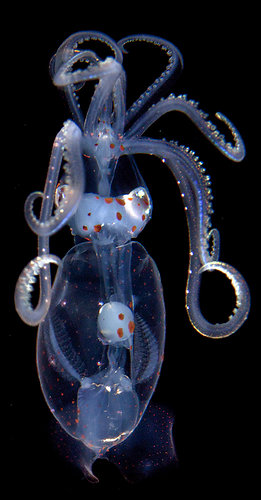
Figure. Dorsal view of a late paralarva of A. lesueurii. Note the long, broad brachial pillar (barely visible). Photograph by Jeffrey Milisen.
Paralarvae of A. lesueurii differ from those of other members of the enoploteuthid families by:
- Relatively small, broadly spaced eyes.
- Separation of the eyes from the arm bases.
- Gelatinous head tissues.
- Posterior position and kidney-bean shape of the digestive gland.


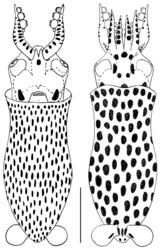

Figure. Paralarvae of A. lesueurii from Hawaiian waters. Far left (thumbnail) - Shows the relative size of the two stages. Left - 2.8 mm ML. Right - 6.2 mm ML; note that the ventral view shows 3 pairs of photophores on the mantle and 1 pair on the head. Each scale bar is 1 mm. Drawings by R. Young.
The tentacular clubs of advanced paralarvae are distinctive in having the suckers of the lateral series larger than suckers of the medial series.

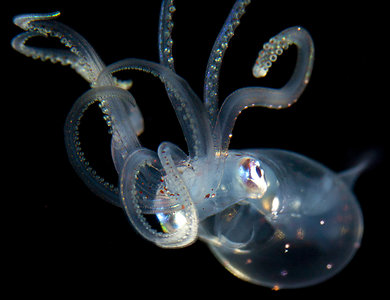

Figure. Left - Anterior view of the same, late paralarva of A. lesueurii as above. Note the peculiar tentacular club and the photophores on the mantle and tentacles. Photograph by Jeffrey Milsen. Right - Drawing of the paralarval club, from Naef, 1921/23.
The early paralarvae can be confused with Octopoteuthis paralarvae by the large suckers on the clubs but are easily distinguished by the more numerous club suckers and more muscular tentacles in the former as well as the lack of a disc-shaped digestive gland characteristic of the latter genus.
Distristribution
This species is found throughout the tropical and subtropical oceans of the world (Young et al., 1998).Insufficient material has been available for critical species-level comparisons of specimens from different regions.
References
Appellof, A. 1890. Teuthologische Beitrage I. Ctenopteryx n.g., Veranya sicula Krohn, Calliteuthis Verrill. Bergens Museums Aarsbertning, 1889(3):1-34.
Clarke, M.R. 1988. Evolution of Recent Cephalopods - A Brief Review. pp. 331-340. In: M.R. Clarke and E.R. Trueman, (eds.), The Mollusca, Vol. 12, Paleontology and Neontology of Cephalopods. Academic Press.
Gray, J.E. 1849. Catalogue of the Mollusca in the Collection of the British Museum, Part I. "Cephalopoda Antepedia". London, British Museum (Nat. Hist.), 164 pages.
Naef, A. 1921-1923. Die Cephalopoden. Fauna e Flora del Golfo di Napoli, Monographie 35, Vol I, Parts I and II, Systematik, pp 1-863.
Nesis, K. N. 1978. The subfamily Ancistrocheirinae (Enoploteuthidae). Zoologichesky Zhurnal, 57(3):446-449. (In Russian, English summary).
Nesis, K. N. 1982. Abridged key to the cephalopod mollusks of the world's ocean. 385+ii pp. Light and Food Industry Publishing House, Moscow. (In Russian.). Translated into English by B. S. Levitov, ed. by L. A. Burgess (1987), Cephalopods of the world. T. F. H. Publications, Neptune City, NJ, 351pp.
Okutani, T. 1974. Epipelagic decapod cephalopods collected by micronekton tows during the EASTROPAC expeditions, 1967-1968 (systematic part). Bull. Tokai Reg. Fish. Res. Lab., 80: 29-118.
Orbigny, A.d' 1834-48. In A. d'Ferussac and A. d'Orbigny, A., 1834-1848. Histoire Naturelle Generale et Particuliere Cephalopodes Acetabulifäres Vivants et Fossiles, J.B. Bailliere, Paris, 96 pages + LVI + 361 pages. Atlas of 144 plates.
Pfeffer, G. 1900. Synopsis der oegopsiden Cephalopoden. Jahrbuch der Hamburgischen Wissenschafthchen Anstalten, 17(2):147-198.
Verany, J.B. 1851. Cephalopodes de la Mediterranee. Mollusques Mediterraneens Observes, Decrits, Figures et Chromolithographies d'gores le vivant ouvrage dedii ASM le roi Charles Albert, I:1-132, 41 plates.
Young, R. E., L. A. Burgess, C. F. E. Roper, M. J. Sweeney and S. J. Stephen. 1998. Classification of the Enoploteuthidae, Pyroteuthidae and Ancistrocheiridae. Smithsonian Contr. to Zoology, 586: 239-255.
Young, R. E. and R. Harman. 1998. The phylogeny of the "enoploteuthid families." Smithson. Contr. Zool., No. 586: 257-270.
Young, R. E., Mangold, K. M., & Vecchione, M. (1992). The enoploteuthid group of families. Larval and Juvenile Cephalopods: a Manual for Their Identification. Smithson. Contrib. Zool, 513, 187–210.
Title Illustrations

| Location | Gulf of California at 25.45°N, 109.84°W |
|---|---|
| Comments | Various in situ views of Ancistrocheirus lesueurii at 1552 m. Top left - Side view showing streamline configuration for rapid swimming. Top right - Anterior view. Note the tentacular clubs are locked together. Bottom left - Posterior oblique view. Note the large photophores along the tentacular stalk (see arrow). Bottom right - Side view. Note the large fins and the photophores on the mantle, head and arm bases. All four photographs © 2012 MBARI |
| Acknowledgements | Image courtesy of the Monterey Bay Aquarium Research Institute (MBARI). You must obtain permission from MBARI to use this photo; please contact pressroom@mbari.org for further information |
| Size | Unknown |
| Copyright | © 2012 MBARI |
About This Page

National Museum of Natural History, Washington, D. C. , USA

University of Hawaii, Honolulu, HI, USA
Page copyright © 2019 and
 Page: Tree of Life
Ancistrocheiridae . Ancistrocheirus lesueurii . Ancistrocheirus .
Authored by
Michael Vecchione and Richard E. Young.
The TEXT of this page is licensed under the
Creative Commons Attribution-NonCommercial License - Version 3.0. Note that images and other media
featured on this page are each governed by their own license, and they may or may not be available
for reuse. Click on an image or a media link to access the media data window, which provides the
relevant licensing information. For the general terms and conditions of ToL material reuse and
redistribution, please see the Tree of Life Copyright
Policies.
Page: Tree of Life
Ancistrocheiridae . Ancistrocheirus lesueurii . Ancistrocheirus .
Authored by
Michael Vecchione and Richard E. Young.
The TEXT of this page is licensed under the
Creative Commons Attribution-NonCommercial License - Version 3.0. Note that images and other media
featured on this page are each governed by their own license, and they may or may not be available
for reuse. Click on an image or a media link to access the media data window, which provides the
relevant licensing information. For the general terms and conditions of ToL material reuse and
redistribution, please see the Tree of Life Copyright
Policies.
- Content changed 16 November 2016
Citing this page:
Vecchione, Michael and Richard E. Young. 2016. Ancistrocheiridae . Ancistrocheirus lesueurii . Ancistrocheirus . Version 16 November 2016 (under construction). http://tolweb.org/Ancistrocheirus_lesueurii/19632/2016.11.16 in The Tree of Life Web Project, http://tolweb.org/




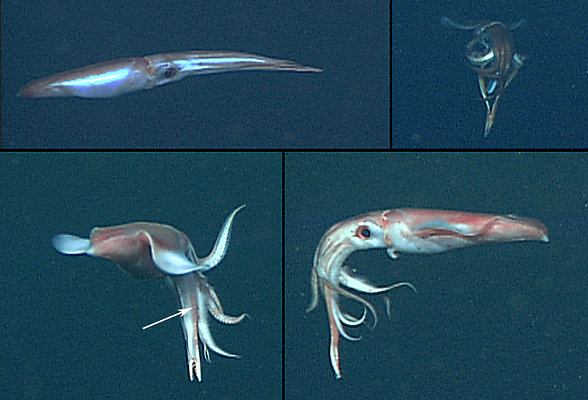
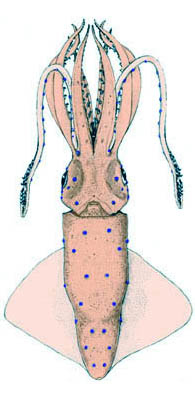
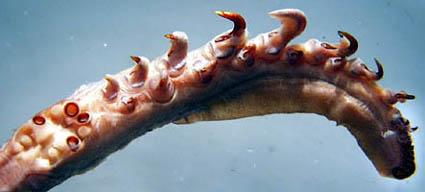
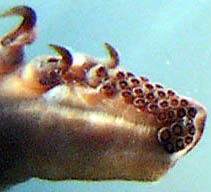
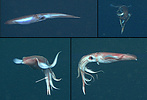



 Go to quick links
Go to quick search
Go to navigation for this section of the ToL site
Go to detailed links for the ToL site
Go to quick links
Go to quick search
Go to navigation for this section of the ToL site
Go to detailed links for the ToL site